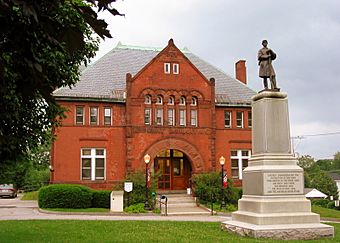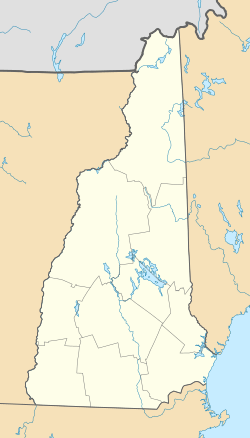East Jaffrey Historic District facts for kids
Quick facts for kids |
|
|
East Jaffrey Historic District
|
|

The Jaffrey Library
|
|
| Location | Roughly along NH 124 and US 202, Jaffrey, New Hampshire |
|---|---|
| Area | 75 acres (30 ha) |
| NRHP reference No. | 02000642 |
| Added to NRHP | June 14, 2002 |
The East Jaffrey Historic District is a special area in Jaffrey, New Hampshire. It's like a time capsule, showing how the town grew. This district is found along NH Route 124 (Main Street). It includes the main business and community parts of Jaffrey.
The district is centered around the Jaffrey Mills and where Route 124 crosses the Contoocook River. It stretches out in different directions. You can find old homes from the early 1800s here. There are also factory buildings and houses linked to the Jaffrey Mills. This important district was added to the National Register of Historic Places in 2002.
Contents
Discovering East Jaffrey's History
The town of Jaffrey was first planned in the 1740s. It officially became a town in 1773. The very first town center was located in a different spot. That area is now known as the Jaffrey Center Historic District.
How East Jaffrey Began
The village of East Jaffrey started thanks to John Boorland. In 1770, he built sawmills and gristmills here. These mills helped process wood and grain. They were located on the Contoocook River.
Growth and Development
In 1799, a new road was built near the mills. This road is now NH 124. It brought more people and businesses to the area. This helped East Jaffrey grow even more.
In 1814, the old mills were replaced by a woolen mill. This was the start of the Jaffrey Mills buildings we see today. They are along the river, north of the Main Street bridge.
A Busy 19th Century
By the mid-1800s, East Jaffrey was a busy place. Many Greek Revival style houses were built. These homes have a classic, grand look. More businesses and community buildings also appeared.
The arrival of the railroad in 1870 was a big deal. It made East Jaffrey even more important for business and town life. The railroad helped connect the town to other places.



